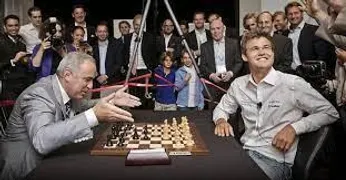When 13-Year-Old Carlsen Nearly Beat Kasparov: A Prodigy's Masterpiece

In 2004, at a rapid chess tournament in Reykjavik, Iceland, something extraordinary happened. A 13-year-old Norwegian boy, already a Grandmaster, sat across from the legendary Garry Kasparov - at the time still the highest-rated player in the world. What followed was a game that equals or surpasses the peak performances of past prodigies like Capablanca and Fischer.
The David and Goliath Match-Up
The rating difference was staggering: 347 Elo points separated the young Magnus Carlsen from the former world champion. Yet despite this enormous gap, Carlsen not only held his ground but nearly claimed victory. This game demonstrates why Carlsen would go on to become world champion and dominate chess for over a decade.
Game Overview
Event: Reykjavik Rapid 2004 White: Magnus Carlsen Black: Garry Kasparov Opening: Queen's Gambit Declined Result: ½-½
The Opening: Carlsen's Fearless Approach
Moves 1-9: Classic Queen's Gambit
1.d4 d5 2.c4 c6 3.Nf3 Nf6 4.Nc3 e6 5.Bg5 Nbd7 6.e3 Qa5 7.Nd2 Bb4 8.Qc2 0-0 9.Be2 e5
Black strikes with the thematic freeing break 9...e5, a move that challenges White's central control. This is standard Queen's Gambit Declined theory, but what comes next shows Carlsen's aggressive intentions.
Move 14: The Bold a4!?
After the sequence 10.0-0 exd4 11.Nb3 Qb6 12.exd4 dxc4 13.Bxc4, Carlsen played the provocative 14.a4!?
After 14.a4!? - Carlsen creates dynamic play at the cost of a structural weakness on b4.
This move creates a permanent weakness on b4, but the 13-year-old Carlsen understood something crucial: dynamic factors override static weaknesses. This uncompromising approach would become a hallmark of his style.
Critical Moment #1: Kasparov's Trap (Move 17)
After 15.Rae1!? h6 16.Bh4 Bd6, Carlsen played the powerful 17.Bxf6!, eroding Black's control over the crucial d5 square.
Kasparov responded with the clever 17...Nxc4, setting a trap. Can you spot it?
After 17...Nxc4 - Kasparov sets a deadly trap. If 18.Bg3? then 18...Qg6+!! wins immediately!
What if White plays 18.Bg3, attacking the bishop?
Black has the stunning 18...Qg6+!! - a move that forces immediate resignation! After the queen sacrifice, Black delivers checkmate.
Carlsen avoided this trap and continued 18...Nxc4 19.Ne4!, maintaining pressure.
The Turning Point: Move 20
After 19...Bh2+!, Kasparov found the best defensive try. But then came 20...Nd6? - a critical error.
The Missing Defense
Kasparov should have played 20...b5! with the complex continuation:
21.g3! Bxh3 22.Kxh2 Bxf1 23.Nbxc5! Qc5 24.Rxf1 Qf5! 25.Qc1! Rfe8 26.f3
This extraordinary sequence would have given Black excellent drawing chances with rook and pawns against bishop and knight.
Carlsen's Winning Attempt
After 20...Nd6?, White achieved a clearly better position with 21.Kxh2 Nxe4+ 22.Bg5 Nd6 23.Qc5.
After 23.Qc5 - White has strong pressure, but 23.d5! would have been even more devastating.
Even stronger was the computer-like 23.d5!, which would have given White overwhelming pressure:
23.d5! Qd7 24.dxc6 bxc6 25.Re2!! Nf5 26.Rd1 Qa7 27.Nd4!
This cold-blooded attacking sequence shows the kind of calculation that would later make Carlsen world champion.
The Endgame: Kasparov's Resilience
Despite being a pawn down and under constant pressure, Kasparov's legendary defensive skills came to the fore. The game transitioned into an opposite-colored bishop endgame, where the drawing tendencies of such positions offered Black hope.
Critical Mistake: Move 32
Carlsen played 32.Qg4?!, offering a queen trade. While practical against most opponents, against Kasparov this significantly reduced White's winning chances.
Better was 32.f3! Rac8 33.Bg3, maintaining all the pieces and continuing to squeeze.
The Final Phase: A Drawn Endgame
After 32...Qxg4 33.hxg4 Bc6!, Black's bishop reached the long diagonal and White's advantage evaporated. Despite being a pawn up, Carlsen couldn't find a way through Kasparov's fortress.
After 33...Bc6 - The opposite-colored bishops and Black's solid structure make this position drawable despite White's extra pawn.
The game concluded with 34.b3 f6 35.Bc3 Rxe1 36.Rxe1 Bxd5 37.Rb1 Kf7 and was eventually drawn after 52 moves.
Lessons from This Game
1. Dynamic Play Trumps Static Weaknesses
Carlsen's 14.a4!? showed that in sharp positions, activity and piece placement matter more than pawn structure.
2. Stay Alert for Tactical Traps
Even against a 13-year-old, Kasparov set sophisticated traps like the 18...Qg6+ tactic.
3. Calculate Precisely in Critical Moments
The missed 23.d5! shows that even prodigies can improve their calculation accuracy.
4. Endgame Technique Matters
Carlsen's decision to trade queens (32.Qg4?!) demonstrates that even future world champions must continuously refine their endgame judgment.
5. Opposite-Colored Bishops Draw
This game beautifully illustrates why opposite-colored bishop endgames have such strong drawing tendencies, even when one side is a pawn up.
What This Game Means
This encounter between 13-year-old Carlsen and the legendary Kasparov represents more than just a drawn game. It was a passing of the torch, a glimpse into the future of chess. The fearlessness, the aggressive style, the willingness to take calculated risks - all these traits that would define Carlsen's world championship reign were already present.
Want to Learn More?
Understanding games at this level requires dedicated study and strong foundations. As an elite player who specializes in teaching beginners and intermediate players, I can help you:
- Understand the strategic concepts behind moves like 14.a4!?
- Develop your tactical vision to spot traps like 18...Qg6+
- Improve your calculation skills
- Master critical endgame positions
Book a personalized lesson to take your chess to the next level!
This analysis is based on "Carlsen: Move by Move" and demonstrates the early genius of Magnus Carlsen, who would go on to become the longest-reigning world champion in chess history.